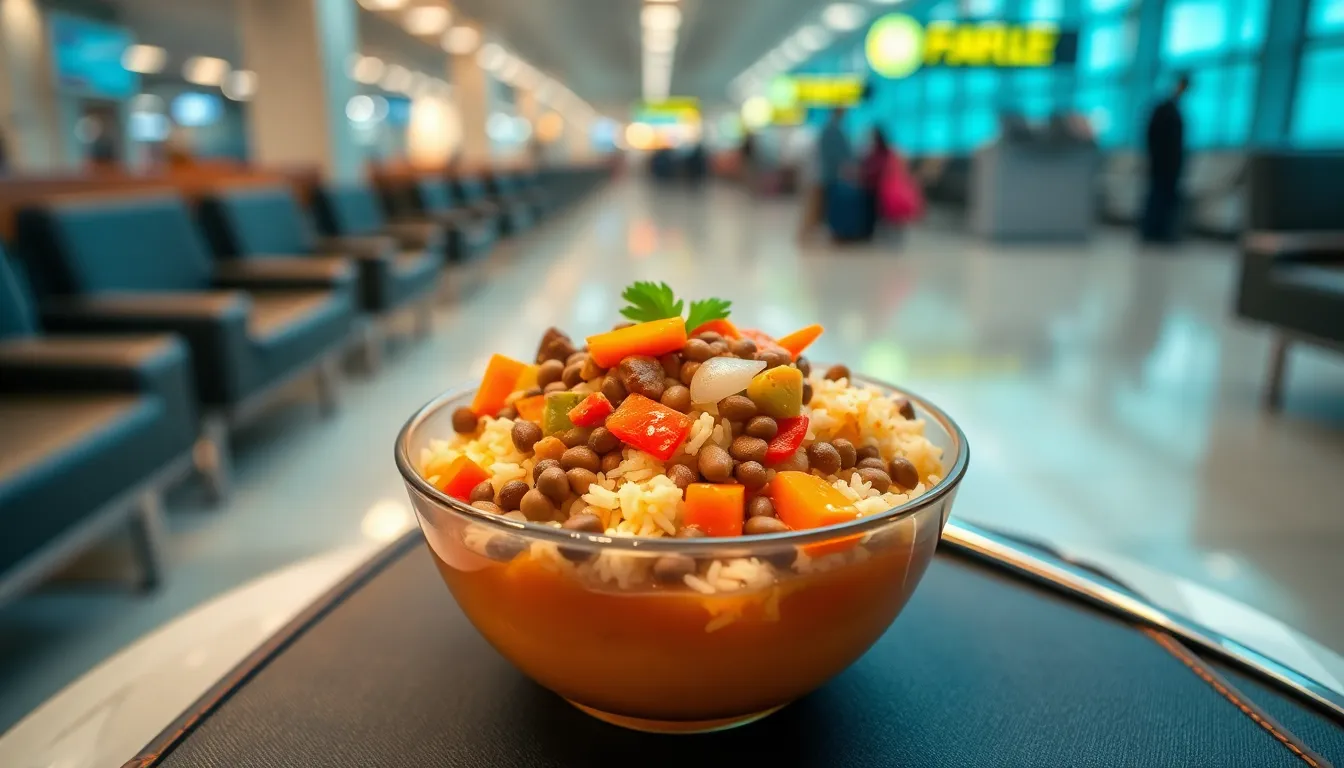Traveling can be an adventure, but figuring out what to bring can feel like a scavenger hunt. When it comes to snacks, the question often pops up: can I take food kayudapu on a plane? If you’ve ever savored the rich flavors of this delightful dish, you know it’s hard to resist packing some for your journey.
Table of Contents
ToggleUnderstanding Kayudapu
Kayudapu represents a traditional dish popular in various cultures. It features a rich blend of flavors that makes it a tempting choice for travelers.
What Is Kayudapu?
Kayudapu refers to a savory dish typically made with rice and legumes. Originating from multiple regional cuisines, its preparation often varies. Many enjoy it for its unique taste and filling nature. Various cultures prepare kayudapu with local twists, enhancing its appeal across different palates. Food enthusiasts appreciate its nutritional benefits as well.
Common Ingredients in Kayudapu
Common ingredients in kayudapu include rice, lentils, and spices. These components contribute to the dish’s hearty texture and flavor. Often, vegetables like carrots and onions are added for extra nutrition and taste. Spices such as turmeric, cumin, and coriander elevate its aromatic profile. Each ingredient plays a significant role in defining kayudapu’s character. Various regional recipes might incorporate unique elements, showcasing local culinary traditions.
Airline Regulations on Food

Travelers often wonder about regulations regarding bringing food on airplanes, specifically traditional dishes like kayudapu. Understanding airline rules can help avoid surprises at security checkpoints.
TSA Guidelines for Food Items
TSA regulations permit most solid food items in carry-on luggage. Foods like kayudapu can generally pass through security, provided they don’t contain liquids above the allowed limit. Perishable foods may require a cooler bag to maintain freshness. Screening procedures often include additional inspections for food items, so it’s wise to have them easily accessible. Always check with the TSA website for the latest updates on specific food restrictions.
International Travel Considerations
International flights impose additional regulations, often influenced by destination countries. Some nations restrict certain food items, particularly fresh produce, meats, and dairy products. When traveling with kayudapu, consider its ingredients and how they align with customs regulations. Declaring food on arrival may be necessary to avoid fines. Review applicable customs rules before departure to ensure all items comply with import regulations.
Best Practices for Packing Kayudapu
Packing kayudapu requires some attention to detail to ensure freshness and compliance with airline regulations. Knowing the right techniques makes the process smoother for travelers.
Packaging Tips
Select airtight containers when packing kayudapu. These containers prevent spillage and preserve flavors. Opt for lightweight materials, as heavy containers add extra weight to luggage. Consider using vacuum-sealed bags for additional freshness, especially for longer flights. Label containers with the dish’s name and ingredients to expedite any security checks. Avoid packing with liquids that exceed TSA guidelines to ensure seamless inspections. Keep extra utensils handy for easy serving and enjoying on the plane.
Storing Kayudapu for Freshness
Storing kayudapu properly helps maintain its taste. Use a cooler bag if traveling through warmer climates to retain its temperature. Ice packs can enhance the cooling effect, especially with perishable ingredients. Consume kayudapu within a few hours of preparation to ensure optimal flavor and safety. If traveling internationally, consider consuming it soon after boarding, as customs regulations may restrict bringing it into certain countries. Always check local guidelines regarding food items before arriving at your destination.
Alternative Snack Options for Travelers
Travelers seeking alternatives to kayudapu can opt for a variety of snacks that are easy to pack and eat.
Portable Snacks
Protein bars, for instance, offer a convenient and energy-boosting option for long flights. Nuts and dried fruits serve as excellent choices due to their high nutritional value and minimal packaging. Crackers, paired with cheese or hummus, can complement any travel meal without worrying about mess. Granola bites are also easy to carry and provide a satisfying crunch during travel. These options maintain freshness, align with TSA regulations, and provide a quick source of sustenance.
Healthy Choices
Fruits such as apples and bananas deliver natural sweetness without added sugars. Vegetable sticks, like carrots and celery, ensure a crunchy and nutritious snack. Whole grain wraps filled with fresh veggies or lean proteins create a balanced option that’s portable. Yogurt cups, granted they meet liquid restrictions, enhance probiotic intake, promoting gut health. These healthy choices accommodate diverse dietary preferences and keep travelers energized throughout their journey.
Traveling with kayudapu can be a delightful experience if done thoughtfully. By understanding airline regulations and customs rules, travelers can enjoy this flavorful dish without hassle. Proper packing techniques are essential for maintaining freshness and ensuring compliance with TSA guidelines.
For those who choose to bring kayudapu on their journey, using airtight containers and cooler bags can make a significant difference. Being aware of alternative snack options can also provide a well-rounded travel experience. With careful planning and consideration, kayudapu can be a tasty companion on any flight.




